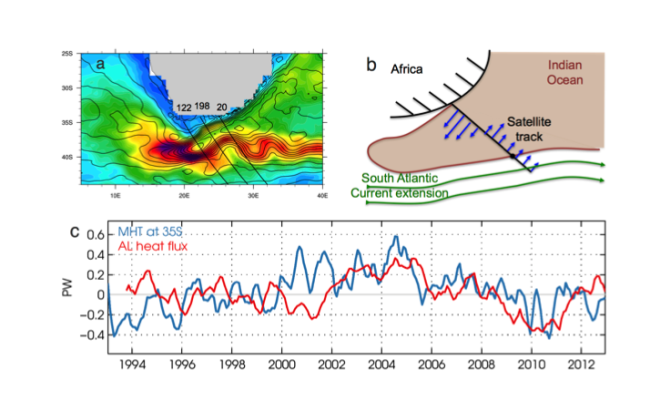Agulhas leakage, not salinity, linked to the Atlantic meridional circulation slowdown
The Atlantic Meridional Overturning Circulation (AMOC) moves warm, salty water northward, while cool, fresh water is transported southward. At high-latitudes, the salty water cools and sinks, and this sinking is commonly thought to force the overturning circulation. Climate models predict a slowdown of the AMOC, causing freshwater to converge and inhibit sinking to further weaken the AMOC.

An alternative source for AMOC anomalies is the wind-forced Southern Hemisphere circulation. Warm, salty water flows into the South Atlantic primarily from the Indian Ocean where the Agulhas Current leaks large quantities of heat. Some recent studies suggest that heat, not fresh water, forces anomalies in AMOC, particularly in a warming climate.
A slowdown of the AMOC over the recent decade has been documented using the Atlantic-spanning RAPID array at 26°N. A recent study, published in Geophysical Research Letters, combined sea level and gravity from satellites with ocean temperature and salinity data to spatially extrapolate heat and freshwater transport anomalies at the RAPID array and examine their source. The study revealed a high level of coherence of heat and freshwater transports from 35°S to 67°N, with estimates robust between several different flux products.
A decadal anomaly in the AMOC was shown to be consistent in magnitude and phase with changes in the Agulhas Leakage, which was estimated using sea level. The slowing of the AMOC caused freshwater convergence in the North Atlantic, as expected. However, salinity from 40°N to 67°N continued to increase owing to a larger decrease in precipitation. The study concluded that the likely source of the heat transport anomalies was a decrease in the Agulhas Leakage and that changes in convection in the subpolar North Atlantic was an unlikely contributor to the slowdown.
Impact of slowdown of Atlantic overturning circulation on heat and freshwater transports (Geophysical Research Letters)
1University of Washington
2Royal Netherlands Meteorological Institute (KNMI), Netherlands
3National Oceanography Centre, University of Southampton, United Kingdom
Topics
- Atlantic Ocean
- Climate Change
- AMOC
